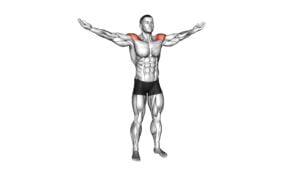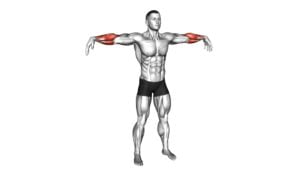Mid Air Lateral Raises With Switching Palms (female) – Video Exercise Guide & Tips

Are you looking to tone your arms and build upper body strength? Look no further than mid air lateral raises with switching palms! This exercise targets your shoulder muscles and helps improve overall shoulder stability.
Watch This Exercise Video
In this video exercise guide, you'll learn the proper form and technique, as well as tips for progression and variation.
So grab some dumbbells and get ready to feel the burn!
Key Takeaways
- Mid air lateral raises target and improve shoulder muscles, stability, strength, and overall stability.
- Proper form and technique involve standing with feet shoulder-width apart, holding dumbbells with arms down by sides, and raising arms out to the sides until they are parallel to the floor.
- Choosing the right weight involves considering current strength level, maintaining proper form, gradually increasing weight as strength improves, and selecting a weight for 8-12 repetitions.
- Common mistakes to avoid include using improper form, lifting weights that are too heavy, neglecting proper breathing, not engaging the targeted muscles, and skipping warm-up before exercise.
Benefits of Mid Air Lateral Raises
To maximize your upper body strength and shoulder stability, incorporating mid air lateral raises into your workout routine can provide numerous benefits. These exercises specifically target your shoulder muscles, helping to increase shoulder strength and improve overall stability. By performing mid air lateral raises, you engage the deltoid muscles in your shoulders, which are responsible for the majority of the movement in this exercise. This targeted activation helps to build strength in the shoulders, allowing you to lift heavier weights and perform other upper body exercises with ease.
In addition to shoulder strength, mid air lateral raises also contribute to increased range of motion in your shoulders. As you raise your arms out to the sides, you're stretching the muscles in your shoulders, improving their flexibility and mobility. This increased range of motion can be beneficial in many aspects of your daily life, such as reaching for objects overhead or performing various sports activities.
To ensure you get the most out of mid air lateral raises, it's important to maintain proper form and technique. By keeping your core engaged, your back straight, and your shoulders relaxed, you can prevent unnecessary strain and injury. Transitioning into the subsequent section about proper form and technique, you'll learn the key elements to perform mid air lateral raises correctly and safely.
Proper Form and Technique
Maintain proper form and technique for mid air lateral raises by focusing on engaging your core, keeping your back straight, and relaxing your shoulders. Proper form is essential for improving shoulder strength and preventing injuries during this exercise.
Here are some key tips to ensure you perform mid air lateral raises correctly:
- Stand with your feet shoulder-width apart and hold a dumbbell in each hand.
- Start with your arms down by your sides, palms facing your thighs.
- Slowly raise your arms out to the sides, keeping a slight bend in your elbows.
- Stop when your arms are parallel to the floor, making sure not to swing or use momentum.
- Lower your arms back down to the starting position in a controlled manner.
By following these guidelines, you'll engage the targeted muscles effectively while reducing the risk of strain or injury. Remember to maintain proper posture throughout the movement, keeping your core engaged and your back straight. This will help to isolate and strengthen your shoulder muscles while minimizing stress on other areas of your body.
Focus on performing the exercise with control and precision, rather than rushing through it. By practicing proper form and technique, you can maximize the benefits of mid air lateral raises while minimizing the risk of injury.
Choosing the Right Weight
To choose the right weight for mid air lateral raises, consider your current strength level and ability to maintain proper form and technique. Weight selection is crucial in order to challenge your muscles without straining or compromising your form. Finding the right resistance is important to maximize the benefits of this exercise.
Start by assessing your current strength level. If you're a beginner, it's recommended to start with lighter weights to focus on proper form and technique. As you progress, you can gradually increase the weight to continue challenging your muscles.
Another factor to consider is your ability to maintain proper form throughout the exercise. If you find yourself struggling to lift the weight or compromising your posture, it may be too heavy. On the other hand, if you can easily complete the exercise without feeling any resistance, it may be too light.
A good rule of thumb is to choose a weight that allows you to perform 8-12 repetitions with proper form and technique. This range ensures that you're challenging your muscles enough to promote strength and endurance gains.
Common Mistakes to Avoid
Avoid these common mistakes when performing mid air lateral raises with switching palms:
- Using improper form: One of the most common mistakes is using improper form, such as swinging the weights or arching your back. This can decrease the effectiveness of the exercise and increase the risk of injury.
- Lifting too heavy: Avoid the temptation to use weights that are too heavy for you. Start with lighter weights and gradually increase the resistance as your strength improves. This will help you maintain proper form and prevent strain.
- Neglecting proper breathing: Breathing properly during the exercise is essential. Remember to exhale as you lift the weights and inhale as you lower them. This will help stabilize your core and enhance the effectiveness of the exercise.
- Not engaging the right muscles: It's important to focus on the targeted muscles, which in this case are the deltoids. Avoid using momentum or relying on other muscles to lift the weights. Instead, concentrate on engaging and isolating the deltoids throughout the movement.
- Skipping warm-up: Before starting any exercise, including mid air lateral raises, make sure to warm up properly. This helps increase blood flow to the muscles, improves flexibility, and reduces the risk of injury.
Tips for Progression and Variation
To progress and vary your mid air lateral raises with switching palms (female), you can incorporate different weights, angles, or tempo in your workouts. These progression techniques and exercise modifications will help challenge your muscles and ensure continued improvement.
One way to progress is by increasing the weight you use. Start with lighter dumbbells and gradually increase the load as you get stronger. This will help build muscle endurance and strength. You can also try using resistance bands or weighted cuffs to add resistance and intensity to the exercise.
Another way to vary your mid air lateral raises is by changing the angle of your arms. Instead of raising your arms straight out to the sides, you can try lifting them slightly forward or backward. This will engage different muscles and provide a new stimulus to your shoulders.
Additionally, you can modify the tempo of the exercise to make it more challenging. Slow down the movement and focus on controlling the weight as you raise and lower your arms. This will increase time under tension and improve muscle definition.
Remember to listen to your body and progress at a pace that feels comfortable for you. By incorporating these progression techniques and exercise modifications, you can continue to challenge yourself and achieve your fitness goals.
Frequently Asked Questions
How Many Calories Can I Burn by Doing Mid-Air Lateral Raises?
You can burn calories by doing mid-air lateral raises. This exercise targets your shoulder muscles and can help you achieve a toned upper body.
However, it's important to note that the number of calories burned depends on various factors, such as your weight, intensity, and duration of the exercise.
If you have a shoulder injury or prefer alternatives, consult a fitness professional for modified exercises that suit your needs.
Can I Do Mid-Air Lateral Raises if I Have a Shoulder Injury?
If you have a shoulder injury, it's important to modify your exercises to avoid further damage.
Mid-air lateral raises can be challenging for someone with a shoulder injury, but there are modifications you can make.
Instead of using weights, try using resistance bands or just your body weight. This will help to strengthen the muscles around your shoulder without putting too much strain on the injured area.
Always consult with a healthcare professional before attempting any new exercises.
The benefits of mid-air lateral raises include toning and strengthening your shoulder muscles.
How Often Should I Incorporate Mid-Air Lateral Raises Into My Workout Routine?
To effectively incorporate mid-air lateral raises into your workout routine, consider your overall shoulder training plan. These raises can be a valuable addition, but they shouldn't be the sole focus. Aim for a well-rounded routine by incorporating other shoulder exercises like shoulder presses and bent-over lateral raises.
Mid-air lateral raises can help improve shoulder strength, stability, and posture. To reap the benefits, perform them 2-3 times a week, gradually increasing the weight and reps as you progress.
Are There Any Modifications or Alternative Exercises for Mid-Air Lateral Raises?
For alternative modifications to mid-air lateral raises, you can try using lighter weights or resistance bands to reduce strain on your joints. Another option is to perform lateral raises while seated or against a wall for added stability.
As for the benefits of mid-air lateral raises, they target your shoulder muscles, helping to strengthen and tone them. They also improve shoulder stability and posture. Incorporating them into your workout routine can enhance upper body strength and overall fitness.
Can Mid-Air Lateral Raises Help in Reducing Arm Flab or Toning the Triceps?
Mid-air lateral raises can be effective for reducing arm flab and toning the triceps. By engaging the muscles in your arms and shoulders, this exercise can help to strengthen and define your triceps, leading to a more toned appearance.
Additionally, the controlled movement of raising your arms laterally can help to target and reduce excess fat in the upper arms, contributing to arm flab reduction.
Incorporating mid-air lateral raises into your workout routine can be a beneficial addition for achieving your arm goals.
Conclusion
In conclusion, mid-air lateral raises with switching palms are an effective exercise for building shoulder strength and definition. By maintaining proper form and choosing the right weight, you can maximize the benefits of this exercise while avoiding common mistakes.
Additionally, by incorporating progression and variation into your routine, you can continue to challenge your muscles and see continued progress.
Keep practicing and stay consistent to achieve your fitness goals.

Author
Years ago, the spark of my life’s passion ignited in my mind the moment I stepped into the local gym for the first time. The inaugural bead of perspiration, the initial endeavor, the very first surge of endorphins, and a sense of pride that washed over me post-workout marked the beginning of my deep-seated interest in strength sports, fitness, and sports nutrition. This very curiosity blossomed rapidly into a profound fascination, propelling me to earn a Master’s degree in Physical Education from the Academy of Physical Education in Krakow, followed by a Sports Manager diploma from the Jagiellonian University. My journey of growth led me to gain more specialized qualifications, such as being a certified personal trainer with a focus on sports dietetics, a lifeguard, and an instructor for wellness and corrective gymnastics. Theoretical knowledge paired seamlessly with practical experience, reinforcing my belief that the transformation of individuals under my guidance was also a reflection of my personal growth. This belief holds true even today. Each day, I strive to push the boundaries and explore new realms. These realms gently elevate me to greater heights. The unique combination of passion for my field and the continuous quest for growth fuels my drive to break new ground.







